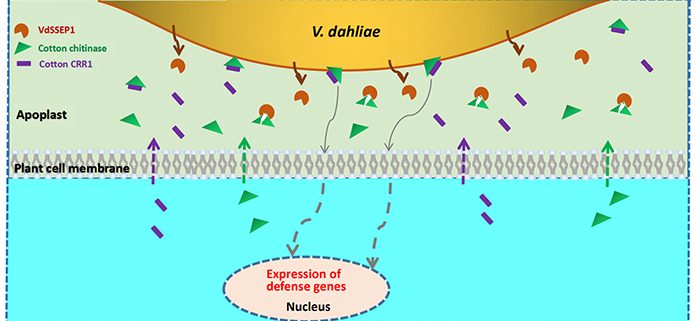How Cotton Protects its Chitinase from a Fungal Protease
Han et al. demonstrate that a cotton secretory protein CRR1 protects cotton Chitinase 28 from cleavage by a pathogen serine protease, VdSSEP1. Plant Cell https://doi.org/10.1105/tpc.18.00390. By Li-Bo Han, Jun Liu and Gui-Xian Xia
Background: The apoplast is an extracellular space in plant tissues. When microbes try to infect plants, the apoplast serves as the first battlefield. For example, fungi attack plants with different enzymes and proteins that limit plant defenses. Plants fight back with chitinase enzymes, which digest the fungal cell wall and release chitin; chitin, in turn, triggers additional plant immune responses. Moreover, the fungi counteract the plant enzymes by releasing proteases, which can break down the plant chitinases. Verticillium wilt is caused by a devastating fungal pathogen, Verticillium dahliae, that attacks cotton. Some varieties of cotton resist Verticillium wilt better than others, so it is interesting to know if the abundance of cotton chitinase is differentially regulated in these cotton varieties.
Question: We wanted to know how the chitinases from some types of cotton survive when they encounter fungal enzymes.
Findings: The fungal pathogen Verticillium dahliae produces a protease, VdSSEP1, that cleaves the cotton chitinase into fragments, thus counteracting the cotton plant’s defenses. We found that a cysteine-rich secreted protein, CRR1, interacted with chitinase in the root apoplast of sea-island cotton, which is resistant to Verticillium wilt disease. What is more, we observed that the interaction between CRR1 and chitinase protected the chitinase from cleavage by VdSSEP1. Therefore, in this plant-pathogen interaction, the plant produces an enzyme to attack the fungus (chitinase), but the fungus produces another enzyme to counteract the plant’s defense (VdSSEP); finally, the plant produces an additional protein (CRR1) that protects its enzyme. Our study thus revealed a multilayered fight between the plant host and the attacking fungal pathogen in the chitin-triggered apoplastic immune response.
Next steps: We will test whether CRR1 can protect chitinase enzymes and thus improve wilt disease resistance in the widely cultivated variety upland cotton by generating transgenic plants with the gene CRR1.
Li-Bo Han, Yuan-Bao Li, Fu-Xin Wang, Wen-Yan Wang, Jun Liu, Jia-He Wu, Nai-Qin Zhong, Shen-Jie Wu, Gai-Li Jiao, Hai-Yun Wang, Gui-Xian Xia. (2019). The cotton apoplastic protein CRR1 stabilizes chitinase 28 to facilitate defense against the fungal pathogen Verticillium dahliae. Plant Cell https://doi.org/10.1105/tpc.18.00390.
Key words: Cotton; Apoplastic immunity; Secretory cysteine-rich repeat protein; Chitinase
Tags: Biotic interactions, Signals and responses




